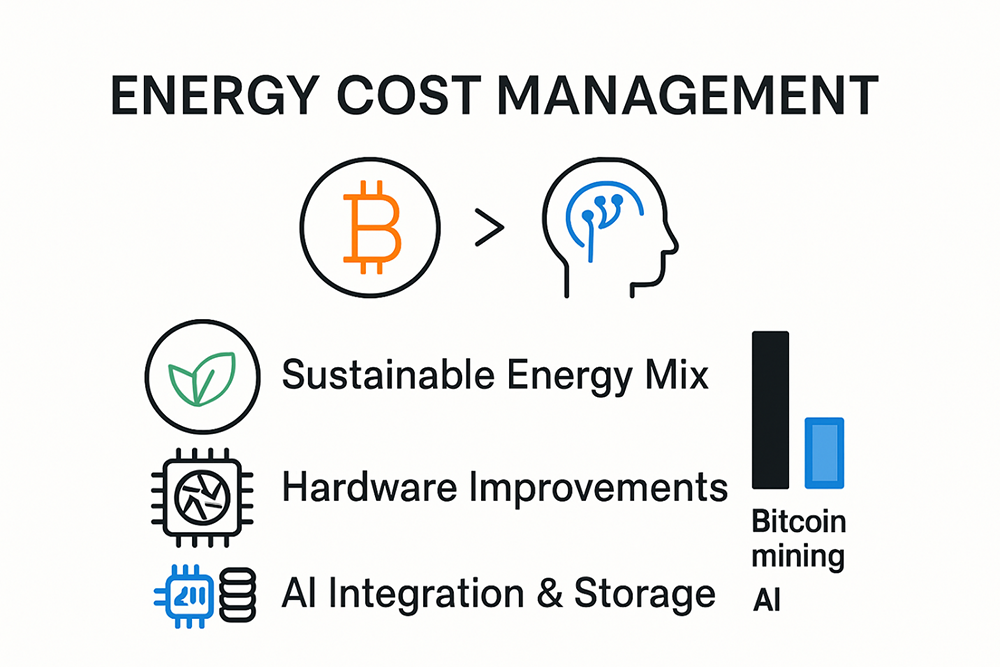
Bitcoin mining and artificial intelligence operations are consuming more electricity than ever, raising real concerns about future energy costs. Here is a shocker. Over half of the energy used for Bitcoin mining now comes from sustainable sources, sitting at 52.4 percent. Most people expect relentless power bills, but a wave of smarter tech and new strategies is rewriting the rules and making both profits and sustainability more achievable than you think.
| Takeaway | Explanation |
|---|---|
| Sustainable Energy Mix | As of now, 52.4% of Bitcoin mining energy comes from sustainable sources, showcasing a shift towards more environmentally responsible practices. |
| Advanced Hardware Importance | Implementing cutting-edge hardware solutions, such as liquid cooling and neuromorphic computing, can lead to up to a 30% reduction in energy consumption. |
| Integration of AI in Energy Management | AI can yield significant annual cost savings by optimizing energy consumption, enhancing predictive maintenance, and facilitating data-driven decisions in energy usage. |
| Renewable Energy and Profitability | Integrating renewable energy sources like solar power not only improves sustainability but also offers impressive returns on investment, enhancing overall economic viability for Bitcoin mining operations. |
| Continuous Innovation is Key | Organizations must continuously invest in research and development for adaptive energy management technologies that align economic performance with environmental responsibility. |

The convergence of Bitcoin mining and artificial intelligence represents a profound technological challenge with substantial energy implications. As computational demands skyrocket, understanding the intricate landscape of energy consumption becomes critical for sustainable technological advancement.
Digital technologies like Bitcoin and AI are not just computational platforms they are intensive energy consumers that dramatically reshape our understanding of power infrastructure. Research from the International Energy Agency projects that data centers could consume over 1,000 terawatt-hours by 2026, driven predominantly by AI and cryptocurrency mining activities.
The energy cost management for these technologies involves multiple sophisticated considerations. Bitcoin mining particularly demands extraordinary electrical resources. A comprehensive study published in Technology in Society revealed that Proof-of-Work cryptocurrencies emit approximately 0.86 metric tons of carbon per transaction, making them significantly more carbon-intensive compared to alternative transaction mechanisms.
Innovative approaches are emerging to address these substantial energy challenges. The Cambridge Centre for Alternative Finance study uncovered a promising trend: sustainable energy sources now account for 52.4% of Bitcoin mining’s energy mix. Natural gas has progressively replaced coal as the primary energy source, signaling a meaningful transition toward more environmentally responsible computational practices.
For Bitcoin and AI operations, energy cost management now requires a multifaceted strategy. This includes optimizing hardware efficiency, leveraging renewable energy sources, implementing advanced cooling technologies, and developing more energy-efficient computational algorithms. Organizations must view energy consumption not just as an operational expense but as a critical sustainability metric.
The economic landscape of energy consumption in Bitcoin and AI is rapidly evolving. As computational demands increase, so do the financial and environmental stakes. Companies and miners must invest in sophisticated energy management strategies that balance performance with sustainability.
The future of digital technologies depends on our ability to develop more energy-efficient computational models. This means not just reducing power consumption but fundamentally reimagining how we design and deploy computational infrastructure. Learn more about our advanced research approaches to understand how innovative solutions are addressing these complex challenges.
Ultimately, energy cost management in Bitcoin and AI is about creating a balanced ecosystem where technological innovation coexists harmoniously with environmental responsibility. The strategies we develop today will shape the computational landscapes of tomorrow.
Before diving into the energy-saving strategies, here’s a summary table comparing the energy sources for Bitcoin mining and their current usage trends, as well as key emission statistics.
| Energy Source | % of Bitcoin Mining Mix | Recent Trend | Emission Impact |
|---|---|---|---|
| Sustainable (Wind/Solar) | 52.4% | Increasing | Low (reduced CO₂ emissions) |
| Natural Gas | Significant | Replacing coal, on the rise | Moderate (lower than coal, still present) |
| Coal | Decreasing | Being phased out | High (major CO₂ contributor) |
| Proof-of-Work Emissions | N/A | N/A | 0.86 metric tons CO₂ per transaction |
| Alternative Mechanisms | N/A | N/A | Lower than Proof-of-Work |
Reducing energy expenses in Bitcoin mining and AI operations requires a strategic approach that combines technological innovation, intelligent infrastructure design, and advanced resource management techniques. Organizations must move beyond traditional cost-cutting methods and embrace comprehensive energy optimization strategies.
Advanced Hardware and Infrastructure Optimization
One of the most effective approaches to energy cost management involves implementing cutting-edge hardware solutions. Research from Vertiv demonstrates that liquid cooling technologies can decrease energy consumption by up to 30% compared to traditional air cooling methods. This significant reduction represents a substantial opportunity for organizations seeking to minimize operational expenses.
Neuromorphic computing research suggests that brain-like processing hardware can dramatically improve energy efficiency. By mimicking neural network structures, these advanced systems consume substantially less power while maintaining high computational performance. Implementing such technologies allows organizations to achieve more computational work with significantly reduced energy expenditure.

Below is a table summarizing advanced hardware and infrastructure strategies, their impact on energy costs, and unique benefits as discussed in this section.
| Strategy/Technology | Estimated Energy Reduction | Unique Benefits |
|---|---|---|
| Liquid Cooling | Up to 30% | Higher cooling efficiency and lower bills |
| Neuromorphic Computing | Substantially less power | Brain-like, high-performance, low energy use |
| Advanced Algorithms | Varies | Improved computational efficiency |
| Infrastructure Optimization | Varies | Maximizes energy use, reduces waste |
Effective energy cost management extends beyond hardware optimization. Advanced research from energy storage studies indicates that implementing sophisticated energy storage systems can reduce electricity bills by up to 20%. These systems enable organizations to manage peak demand more effectively and participate in regulation markets, creating additional financial opportunities.
The intersection of economic considerations and technological capabilities demands a holistic approach to energy cost management. Organizations must view energy consumption not merely as an expense but as a strategic asset that can be optimized and leveraged.
This requires continuous investment in research and development, monitoring emerging technologies, and maintaining flexibility in infrastructure design. Explore our comprehensive research approaches to understand how innovative solutions are transforming energy management in computational environments.
Successful energy cost reduction in Bitcoin and AI operations is not about implementing a single solution but creating an adaptive, intelligent ecosystem that continuously evolves. By embracing advanced technologies, strategic management techniques, and a forward-thinking approach, organizations can achieve significant economic and environmental benefits.
Technology has become a transformative force in energy management, offering sophisticated solutions that go beyond traditional approaches. As computational complexity increases in Bitcoin mining and AI operations, smart technological interventions are becoming crucial for efficient and sustainable energy consumption.
Artificial Intelligence in Energy Optimization
Research from the International Energy Agency reveals the profound potential of AI in energy management, with potential annual cost savings projected at USD 110 billion by 2035. AI-driven systems can revolutionize energy management by providing unprecedented insights and predictive capabilities. Predictive analytics research demonstrates how AI can accurately forecast energy consumption and identify equipment inefficiencies. By analyzing complex data patterns, these systems enable proactive maintenance strategies and optimize production schedules, dramatically reducing unnecessary energy expenditure.
Advanced research in technology integration highlights the power of combining AI with Internet of Things (IoT) and blockchain technologies. This multifaceted approach enables real-time energy monitoring, secure data transmission, and decentralized energy trading, creating more resilient and efficient energy management systems.
Successful energy management now requires a holistic technological approach that transcends traditional boundaries. Organizations must view their energy infrastructure as a dynamic, intelligent ecosystem that continuously adapts and optimizes itself.
This demands ongoing investment in technological research, maintaining flexibility in infrastructure design, and embracing emerging computational paradigms. Explore our advanced research methodologies to understand how innovative technologies are reshaping energy management strategies.
The future of energy management lies not in isolated solutions but in creating interconnected, intelligent systems that can dynamically respond to changing computational demands. By leveraging cutting-edge technologies, organizations can transform energy from a simple operational cost into a strategic competitive advantage.
Maximizing Profits and Sustainability in 2025
The convergence of economic performance and environmental responsibility has become a critical focus for Bitcoin mining and AI operations in 2025. Organizations must now navigate a complex landscape where profitability and sustainability are no longer competing objectives but interconnected strategic priorities.
Groundbreaking research from photovoltaic energy studies reveals remarkable potential for sustainable Bitcoin mining. A comprehensive simulation of a 50.91-MW solar power plant integrated with Bitcoin mining operations demonstrated an impressive return on investment within 3.5 years. More significantly, this approach could prevent approximately 50,000 tons of CO₂ emissions annually, presenting a compelling model for environmentally conscious computational infrastructure. The International Monetary Fund’s economic projections suggest that AI advancements will boost global economic output by 0.5% annually between 2025 and 2030. While this growth presents potential increased carbon emissions from data centers, the economic benefits are anticipated to outweigh environmental costs, provided responsible management strategies are implemented.
Below is a summary table highlighting the key economic and sustainability impacts of renewable energy integration and AI advancements in Bitcoin mining and AI operations as mentioned above.
| Initiative/Development | Projected Impact | Timeframe |
|---|---|---|
| Solar-Powered BTC Mining (50MW) | ROI in 3.5 years; ~50,000 tons CO₂ emissions prevented | Current/Future |
| AI Advancements/IMF Projection | +0.5% global economic output growth per year | 2025-2030 |
| Responsible Management | Economic gains > emissions cost if well-managed | Ongoing |
Advanced AI research in energy informatics demonstrates how machine learning and deep neural networks can revolutionize energy consumption forecasting. These sophisticated models enable precise electricity consumption predictions for commercial operations, allowing organizations to optimize procurement strategies and significantly reduce operational expenses.
Successful organizations in 2025 will view sustainability not as a compliance requirement but as a fundamental competitive advantage. This requires developing holistic strategies that integrate technological innovation, economic performance, and environmental stewardship.
The approach demands continuous investment in research, adaptive infrastructure design, and a commitment to transparent environmental reporting. Explore our comprehensive research methodologies to understand how innovative solutions are reshaping the intersection of technology, economics, and sustainability.
Ultimately, maximizing profits in the computational ecosystem of 2025 requires a nuanced understanding that economic success and environmental responsibility are deeply interconnected. By embracing advanced technologies, data-driven strategies, and a forward-thinking approach, organizations can create value that extends beyond immediate financial metrics.
As of now, 52.4% of the energy used for Bitcoin mining comes from sustainable sources, showcasing a significant shift towards more environmentally responsible practices.
Implementing advanced hardware, such as liquid cooling systems and neuromorphic computing, can lead to energy savings of up to 30% by improving equipment efficiency and reducing power consumption.
Artificial intelligence can optimize energy consumption, enhance predictive maintenance, and facilitate data-driven decisions, which can result in substantial annual cost savings in energy management.
Integrating renewable energy sources like solar power not only improves sustainability but also offers impressive returns on investment, helping Bitcoin mining operations enhance their economic viability while reducing overall carbon emissions.
Struggling with rising power bills and complex energy management in your Bitcoin mining or AI operations? The article above showed how advanced hardware, predictive AI, and renewable energy are changing the game, but knowing where to start can feel overwhelming. With energy now a strategic asset, not just an expense, choosing the right partner makes all the difference.

Let Blockware Solutions help you turn these energy insights into real savings and higher earnings. From expert-hosted miners to on-demand ROI tools and Mining-as-a-Service, our dedicated solutions are built to maximize your efficiency and sustainability. Want to see how fast you can start and save? Visit our homepage now or dig deeper into our research and innovation hub. The energy landscape is changing fast. Make your next move today for a smarter, more profitable future.